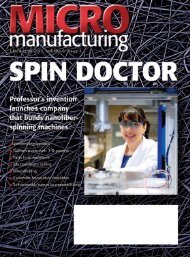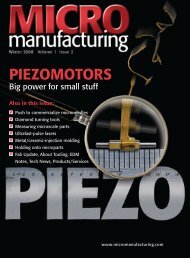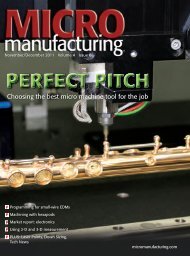to view as PDF - MICROmanufacturing
to view as PDF - MICROmanufacturing
to view as PDF - MICROmanufacturing
Create successful ePaper yourself
Turn your PDF publications into a flip-book with our unique Google optimized e-Paper software.
LASTword<br />
One of the challenges of micromachining<br />
is polishing post-machined part surfaces.<br />
On some microparts, the surface-roughness<br />
dimensions approach those of the part’s<br />
features. In an effort <strong>to</strong> improve manual<br />
polishing techniques, researchers have<br />
examined pulsed l<strong>as</strong>er micropolishing (PLμP).<br />
With PLμP, l<strong>as</strong>er pulses of a specific<br />
duration create shallow melt pools of a<br />
controlled size and depth. This action<br />
causes surface-tension forces <strong>to</strong> “pull down”<br />
<strong>as</strong>perities with a small radius of curvature.<br />
No ablation occurs during the process.<br />
Among those researching micropolishing<br />
is a team consisting of Frank E. Pfefferkorn,<br />
<strong>as</strong>sociate professor, Neil A. Duffie, professor,<br />
and Xiaochun Li, professor, Department of<br />
Mechanical Engineering at the University<br />
of Wisconsin-Madison, and Bill Dinauer,<br />
president of L<strong>as</strong>X Industries, St. Paul, Minn.<br />
In an inter<strong>view</strong> with <strong>MICROmanufacturing</strong>,<br />
Pfefferkorn discussed the team’s research, the<br />
objective of which is <strong>to</strong> improve the finish<br />
that can be achieved on 3-D parts and predict<br />
the final roughness of metal surfaces that<br />
have undergone PLμP. Being able <strong>to</strong> predict<br />
the magnitude of the polishing and frequency<br />
(wavelength) content of the surface will help<br />
establish processing parameters, thereby<br />
minimizing the amount of experimentation<br />
needed before a micropolishing operation is<br />
performed.<br />
The researchers published a paper on<br />
the subject earlier this year in the Journal of<br />
Manufacturing Processes.<br />
<strong>MICROmanufacturing</strong>: How did this<br />
research come about?<br />
Pfefferkorn: It began with discussions<br />
between me and two colleagues, Neil Duffie<br />
and Xiaochun Li. Working with Bill Dinauer<br />
of L<strong>as</strong>X, we developed a research proposal,<br />
obtained funding from the National Science<br />
Foundation and are conducting the research.<br />
We’re now working on commercializing the<br />
process. The motivation for me came from<br />
researching micromilling and realizing that you<br />
always have some residual surface roughness<br />
on microparts. Xiaochun Li found the same<br />
Inter<strong>view</strong> with Prof. Frank E. Pfefferkorn,<br />
University of Wisconsin-Madison<br />
Researchers shine a light on part polishing<br />
48 | MAY/JUNE 2012 | <strong>MICROmanufacturing</strong><br />
with his research in lithography and rapid<br />
pro<strong>to</strong>typing. Surface roughness is a challenge<br />
across the board in micromanufacturing.<br />
Product designers often do not fully<br />
understand the manufacturing processes,<br />
and they will specify <strong>to</strong>lerances within the<br />
roughness range of the finished part.<br />
MICRO: What kinds of surfaces are<br />
suitable for PLμP?<br />
Pfefferkorn: Not every surface on a<br />
micropart needs be polished, so we thought<br />
that if we use a l<strong>as</strong>er, we could selectively<br />
polish critical are<strong>as</strong>. If you have a relatively<br />
flat surface, that’s a pretty e<strong>as</strong>y t<strong>as</strong>k for PLμP<br />
because you can scan l<strong>as</strong>er beams very<br />
quickly. But if it’s a 3-D part, you can’t rotate<br />
the part nearly <strong>as</strong> f<strong>as</strong>t <strong>as</strong> required <strong>to</strong> reach<br />
all the surfaces in an economical manner. If<br />
you need <strong>to</strong> polish the whole part, you might<br />
want <strong>to</strong> use another polishing method.<br />
MICRO: How do you control this process?<br />
Pfefferkorn: To some degree, we can<br />
control how deep the melt pool is b<strong>as</strong>ed<br />
on the beam energy, size and duration.<br />
The re<strong>as</strong>on we use l<strong>as</strong>er pulses rather than<br />
continuous waves is that we have better<br />
control over the melt-pool depth, which is<br />
essential for micropart features that can e<strong>as</strong>ily<br />
be destroyed. After creating a melt pool, the<br />
surface tension pulls down the <strong>as</strong>perities, or<br />
roughness features. By changing the pulse<br />
duration, you can control how long the pool<br />
is liquefied, which controls which roughness<br />
features get smoothed out. We’re using rather<br />
long pulses, ranging from 300 nanoseconds<br />
<strong>to</strong> 10 microseconds, at lower power levels<br />
[<strong>to</strong> ensure] that only melting and no ablation<br />
occurs.<br />
Every surface h<strong>as</strong> both short-wavelength<br />
and long-wavelength features. We’ve learned<br />
that short-wavelength features are e<strong>as</strong>y <strong>to</strong><br />
polish using a 300- <strong>to</strong> 600-nanosecond pulse<br />
duration. But that can still leave much of the<br />
original surface roughness (i.e., the roughness<br />
in long-wavelength features). The surface can<br />
look shiny, but in many c<strong>as</strong>es the Ra value<br />
h<strong>as</strong>n’t changed more than 10 <strong>to</strong> 20 percent.<br />
You’ll need longer pulse durations, such <strong>as</strong><br />
continued on page 47















